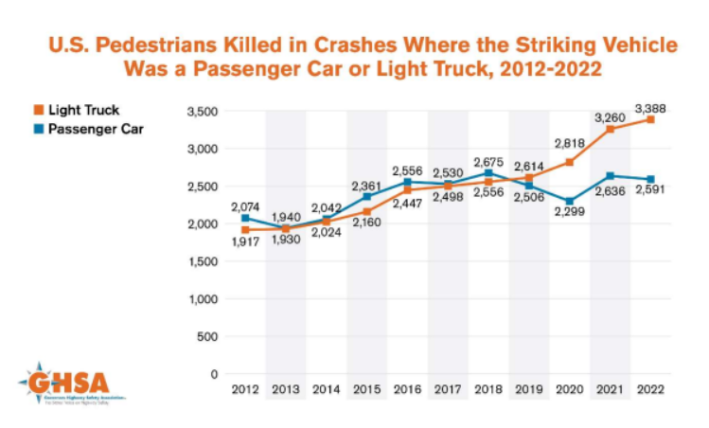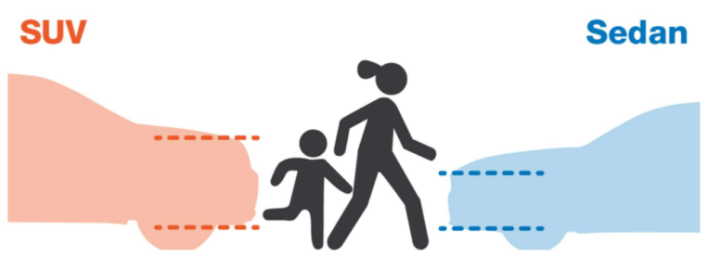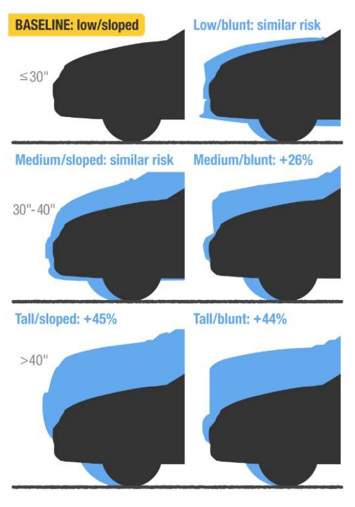The Megacar Crisis: Why Giant Vehicles Pose a Deadly Threat
We’ve known for years that larger vehicles, like SUVs, pickup trucks, and vans, are more dangerous on the road. They’re more likely to cause fatalities to pedestrians, cyclists, and drivers in smaller vehicles. But how has the average car in America gotten so massive, and what can we do to stop the carnage?
This question is addressed in a new report from the Road to Zero Coalition. It presents the first comprehensive look at the research on why this “car bloat” phenomenon is so dangerous and what steps we can take to combat it.
In recent decades, the “light truck” class has exploded in popularity, representing 75% of new vehicles produced today, up from just 20% in 1975. And those vehicles have grown substantially in size, adding 8 inches in height, 10 inches in length, and a staggering 1,000 pounds in weight over the last 30 years. This trend continues as drivers compete in a dangerous “SUV arms race.”

Experts agree that the increased size and weight of vehicles have contributed to the rise in pedestrian fatalities. The Road to Zero Coalition report explores the specific reasons why large vehicles pose a greater risk. The following are six key findings, including a few surprising ones.
1. Height and Weight
It’s a basic law of physics: heavier vehicles are far more dangerous in crashes. According to Newton’s second law, force equals mass times acceleration. Also, taller vehicles are more likely to strike a vulnerable road user at the level of critical internal organs, which makes a fatal injury much more likely.
American megacars are, on average, both heavy and bulky. As electric vehicles continue to gain traction, they will likely become even heavier due to the weight of the batteries.
One 2024 study, cited in the report, looked at real-world crashes and calculated that a pedestrian has a “70 percent greater chance of dying if the vehicle involved [in the crash] is a pickup truck rather than a car, and death is twice as likely if the vehicle is a large SUV rather than a car.”
2. Hood Shape
Even with a tall vehicle, the design of the hood can affect pedestrian safety in a crash. A gently-sloped hood can push a pedestrian up onto the windshield, potentially reducing the severity of injuries. But many U.S. SUVs and trucks have flat, aggressive front ends that send pedestrians directly to the ground, increasing the likelihood of a second, fatal impact as the vehicle passes over their body.

“SUVs, pickups, and vans are not simply scaled-up versions of sedans. […] They have specific design features that can prove deadlier to occupants of other vehicles as well as vulnerable road users.” – Road to Zero Coalition Report
One study looked at nearly 18,000 crashes and found that, even with front ends between 30 and 40 inches high, vehicles with blunt, vertical profiles were 26% more likely to cause pedestrian fatalities than lower, more sloped vehicles.
3. Huge Blind Zones
A tall car with a large, chunky hood can seriously impair a driver’s visibility, even without considering the obvious obstructions. Particularly problematic are the “a-pillars,” the vertical supports flanking the windshield. As vehicles have gotten heavier, these pillars have also grown in size, obstructing a significant portion of the driver’s view during turns.
Increased side mirror sizes present new blind spots, especially for those traveling at an angle to the vehicle. This is a significant factor in the tragic incidents where children are injured or killed in frontover crashes – incidents that tragically happen hundreds of times a year.

Seventy-five percent of these “frontover” crashes involve SUVs, vans, or trucks. A lack of federal standards for forward vision exacerbates the danger, as the report notes.
“Drivers cannot avoid what they cannot see, and while backup cameras have been required by law on all new cars since 2018, there is no required United States standard for forward vision from the driver’s seat. This is in contrast with UN regulations in place for more than 50 countries. Only direct vision – a line of sight between the driver’s own eyes and other road users – allows for eye contact and communication between drivers and those outside the vehicle.”
4. Crash Incompatibility
Larger vehicles don’t just endanger vulnerable road users; they pose a greater risk to occupants of smaller cars. The difference between light trucks and other vehicles contributes to road deaths, despite both types of vehicles using reinforced metal cages.
One analysis found that “side-impact collisions frequently caused head and upper thorax injuries to the occupants of the smaller vehicle because of the high position of the light truck’s bumper.”
In head-on collisions, a large vehicle can push the steering column or instrument panel into the smaller car’s occupants, causing critical injuries.

“With large differences in size or design features, the occupants of smaller, lighter vehicles may be at greater risk of injury or death, and may join the ‘arms race’ by buying a larger vehicle themselves — with all the negative externalities that greater light truck mode share brings to pedestrians and cyclists,” the researchers wrote.
5. Frame Stiffness
Modern megacars are often designed with a stiff frame, which reduces the amount of energy absorbed in a crash and can translate to more damage to whatever object or person is struck.
In a study cited in the report, an electric Polestar 2 (smaller than many popular SUVs) was shown to have about one foot of its front end crushed in a major crash. A non-electric Ford Focus, on the other hand, would have 1.6 feet of its front end demolished in the same crash, potentially increasing the chance of injury to occupants.
Even in less severe collisions, the occupants of megacars can still suffer due to the frame stiffness.
6. Drivers of Huge Cars Are More Likely to Speed
Beyond the physical characteristics of the vehicles, driving behavior is also a factor. Car design provides incentives to go fast. The higher seating position in SUVs affects a driver’s perception of speed, often leading to speeds up to 4 mph faster than in a compact car.
Furthermore, modeling indicates that some drivers may perceive their speed as 10 mph slower in the higher seating position.
The increase in horsepower in new vehicles is another contributor: drivers in high-horsepower vehicles are more likely to exceed the speed limit.

These powerful vehicles also have rapid acceleration capabilities. The electric Hummer, for example, can accelerate from 0 to 60 mph in about three seconds.
There is no practical need for this level of ultra-fast acceleration in everyday vehicle use. And the large battery it requires in already-heavy EVs means greater weight, longer stopping time, and greater force exerted in a crash.
These findings from the Road to Zero Coalition report paint a concerning picture of the dangers posed by ever-larger vehicles. The report’s findings call for changes in regulations and design to enhance road safety for everyone.



